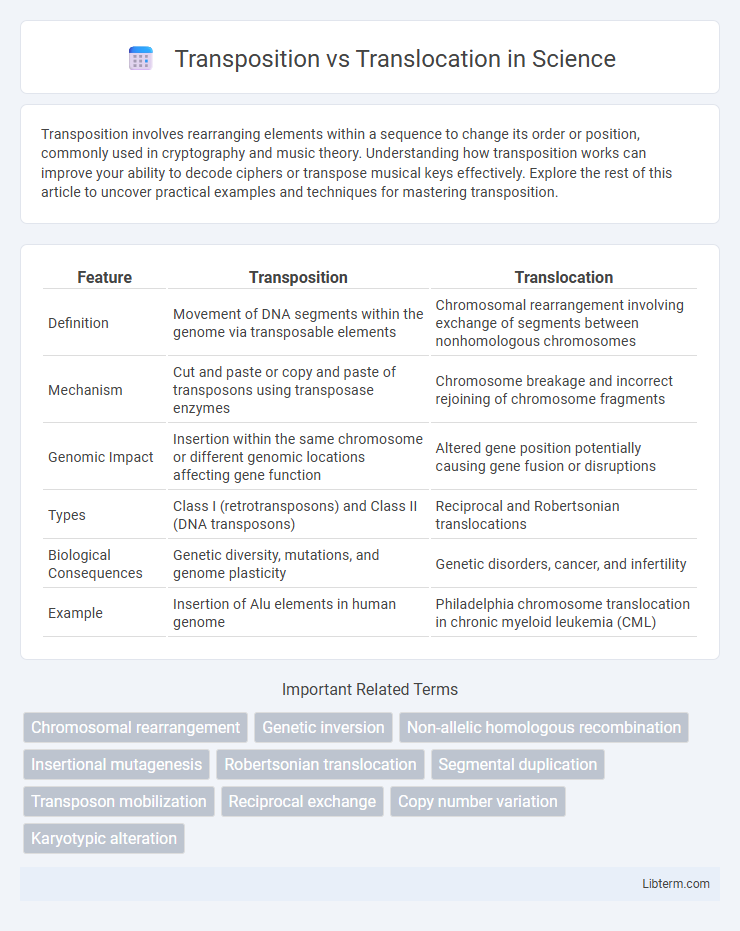Transposition involves rearranging elements within a sequence to change its order or position, commonly used in cryptography and music theory. Understanding how transposition works can improve your ability to decode ciphers or transpose musical keys effectively. Explore the rest of this article to uncover practical examples and techniques for mastering transposition.
Table of Comparison
| Feature | Transposition | Translocation |
|---|---|---|
| Definition | Movement of DNA segments within the genome via transposable elements | Chromosomal rearrangement involving exchange of segments between nonhomologous chromosomes |
| Mechanism | Cut and paste or copy and paste of transposons using transposase enzymes | Chromosome breakage and incorrect rejoining of chromosome fragments |
| Genomic Impact | Insertion within the same chromosome or different genomic locations affecting gene function | Altered gene position potentially causing gene fusion or disruptions |
| Types | Class I (retrotransposons) and Class II (DNA transposons) | Reciprocal and Robertsonian translocations |
| Biological Consequences | Genetic diversity, mutations, and genome plasticity | Genetic disorders, cancer, and infertility |
| Example | Insertion of Alu elements in human genome | Philadelphia chromosome translocation in chronic myeloid leukemia (CML) |
Understanding Transposition and Translocation
Transposition involves the movement of a DNA segment, called a transposon, from one location to another within the genome, often facilitated by the enzyme transposase, which can cause mutations or gene disruptions. Translocation, on the other hand, refers to the rearrangement of parts between nonhomologous chromosomes, frequently resulting in structural chromosome abnormalities that can lead to diseases such as cancer or genetic disorders. Both mechanisms significantly impact genome stability and evolution by altering genetic material but operate through distinct biological processes and consequences.
Key Differences Between Transposition and Translocation
Transposition involves the movement of a DNA segment within the same genome, often mediated by transposons, whereas translocation refers to the rearrangement of chromosome segments between nonhomologous chromosomes. Transposition can create insertional mutations by copying or cutting and pasting genetic elements, while translocation usually affects gene expression and genome stability by exchanging large chromosomal regions. In genetics, transposition is generally a mobile element-driven event, whereas translocation is a chromosomal structural variation detectable in karyotype analysis.
Mechanisms of Genetic Transposition
Genetic transposition occurs through mechanisms involving DNA segments called transposons, which can move within the genome via "cut-and-paste" or "copy-and-paste" methods using enzymes like transposase. Unlike translocation, which involves the exchange of chromosomal segments between non-homologous chromosomes, transposition specifically refers to mobile genetic elements that insert themselves at new genomic sites, sometimes causing mutations or genome rearrangements. These mechanisms are critical for genome diversity and regulation but can also disrupt gene function or genomic stability when transposons insert into coding regions.
Mechanisms of Chromosomal Translocation
Chromosomal translocation involves the rearrangement of parts between nonhomologous chromosomes due to faulty DNA repair mechanisms such as non-homologous end joining (NHEJ) following double-strand breaks. Transposition, by contrast, entails the movement of transposable elements within the same chromosome or to different chromosomes through a "cut-and-paste" or "copy-and-paste" mechanism mediated by transposase enzymes. Translocation generates novel gene fusions or disrupts regulatory regions, often contributing to oncogenesis, whereas transposition mainly affects genome plasticity and gene expression without necessarily involving chromosomal breakage repair.
Biological Consequences of Transposition
Transposition involves the movement of DNA sequences called transposons within the genome, often causing gene disruption, mutations, or altered gene expression patterns, which can lead to genetic diversity or disease development. Unlike translocations, which exchange segments between chromosomes, transposition can create insertions that inactivate tumor suppressor genes or activate oncogenes, contributing to cancer progression. Transposable elements also play a critical role in genome evolution by facilitating chromosomal rearrangements and influencing regulatory networks.
Impacts of Translocation on Genetic Stability
Translocation involves the rearrangement of chromosome segments between nonhomologous chromosomes, often disrupting gene function and leading to genetic instability by causing imbalanced gene expression or loss of genetic material. These chromosomal aberrations can result in diseases such as cancer, infertility, or developmental disorders by interfering with normal cellular processes. Unlike transposition, which generally moves discrete DNA elements within genomes, translocation impacts overall chromosome architecture and genome integrity more profoundly.
Clinical Implications of Transposition
Transposition, particularly in the context of congenital heart diseases such as Transposition of the Great Arteries (TGA), leads to critical circulatory dysfunctions requiring urgent medical intervention after birth. The clinical implications often include cyanosis, heart failure, and the necessity for surgical correction like the arterial switch operation to restore normal blood flow. Early diagnosis through echocardiography and timely surgery significantly improve survival rates and long-term cardiac function in affected patients.
Translocation in Human Diseases
Translocation in human diseases involves the rearrangement of chromosome segments between nonhomologous chromosomes, often leading to gene fusion or dysregulation that drives cancer development, such as the Philadelphia chromosome in chronic myeloid leukemia. Unlike transposition, which involves mobile genetic elements moving within the genome, translocations disrupt normal gene function through abnormal chromosomal exchanges. Identifying translocations is critical for diagnosis and targeted therapies in hematologic malignancies and solid tumors.
Detection and Analysis Methods
Detection and analysis of transpositions primarily involve sequencing technologies like whole-genome sequencing (WGS) and transposon display, which identify mobile genetic elements by mapping insertion sites. Translocations are commonly detected using methods such as fluorescence in situ hybridization (FISH), karyotyping, and next-generation sequencing (NGS) techniques that reveal chromosomal rearrangements at high resolution. Bioinformatics tools further enhance analysis by annotating breakpoint junctions and assessing genomic instability associated with both transpositions and translocations.
Future Perspectives in Genomic Rearrangement Research
Future perspectives in genomic rearrangement research emphasize leveraging advancements in CRISPR-Cas9 and long-read sequencing technologies to precisely characterize and manipulate transpositions and translocations. Emerging bioinformatics tools integrate machine learning algorithms to predict the phenotypic impacts of these structural variants, enabling personalized therapeutic strategies for genetic disorders and cancers. Understanding the interplay between transposable elements and chromosomal translocations will drive innovations in genome stability maintenance and synthetic biology applications.
Transposition Infographic

 libterm.com
libterm.com